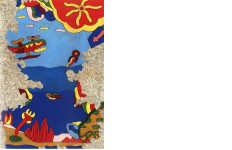Τέμπερα 7Σχέδιο 30Μικτή Τεχνική 58Ακρυλικά 11Γλυπτική 1Ελαιογραφία 14Gouache 1Κατασκευή 3Υδατογραφία 1
Ειδικές Πληροφορίες για τον Καλλιτέχνη
TITΛΟΣ ΕΡΓΟΥΦΑΝΤΑΣΤΙΚΟ ΤΟΠIΟ
ΔΙΑΣΤΑΣΕΙΣ ΕΡΓΟΥΎψος : 131
Πλάτος : 90
ΥΛΙΚΟ ΚΑΤΑΣΚΕΥΗΣΕλαιογραφία (Λάδι σε καμβά)
ΥΠΟΓΡΑΦΗ ΚΑΛΛΙΤΕΧΝΗΚάτω δεξιά και στην πίσω όψη
ΧΡΟΝΟΛΟΓΗΣΗ11-02-1970
ΕΛΕΓΧΟΣ ΓΝΗΣΙΟΤΗΤΑΣΔεν έχει ελεγχθεί

PROVENANCE:
Tassos Zoumboulakis Gallery, Athens.
A bacchanalian revelry of escapist fantasy, daydream vision and perpetual flight, where nature and machine live in perfect communion, Akrithakis' Fantastic landscape invites us to an enchanting world reshaped anew by a charismatic image maker and great poet. "A rousing cheerfulness emanates from the images of Alexis Akrithakis - an infectious cheerfulness inviting us to make merry in a humming meadow, to enter a multicoloured amusement park whose brilliant lights set off emotions. A microcosm in flowing motion, in constant action - a quotidian baroque feast unfurls before us; what the eye catches is transmuted into small, archetypal objects, revealing vague images of a first-hand experience of the world - as in a dream."1
On the outset of the 1970s, as clearly illustrated by this painting, Akrithakis' myth-making skill manifested itself with greater clarity, resulting in more freely structured compositions. The core elements of his signature style, which in his earlier output conveyed a sense of a microcosm seen through a microscope, were enlarged acquiring a more tangible and clearly defined form, while his personal symbols - sun, fire, flying machines, birds and arrows, were depicted with greater confidence.2
The black-and-white sections at the right and left middleground that look like odd protuberances of land into the blue sea are made in the artist's famous and highly personal tsiki-tsiki technique - a name used to describe the sound of pen or charcoal on paper as he drew these curly scribbles in his quiet studio.3 As noted by the celebrated writer Kostas Tachtsis, who prefaced the artist's 1971 show in Athens, "Akrithakis would place his pen at random on a piece of paper and - tsiki-tsiki (it reminded me of Ali Baba's 'open sesame'), tsiki-tsiki, he covered the page with strange-looking shapes."4 Drawing from surrealism's automatic gestures, tsiki-tsiki reflects the importance of writing throughout Akrithakis' career. "In painting, words a~e redundant; in poetry, drawings are redundant; yet you design a poem, you write a painting," the artist himself once noted.
The year 1970 launched one of Akrithakis' most creative periods. Following his first successful shows in Germany and with his work having been well received by the country's art world, Akrithakis, who had been residing in Berlin since 1967 under a German Academic Exchange Service (DAAD) scholarship, decided to remain in the city even after the expiration of his scholarship, to pursue a highly promising career in painting. During this period he started collaborating with Alexander lolas, the highly influential art dealer and gallery owner. Based on his vast experience and farsighted acumen, lolas was quick to detect Akrithakis' talent and undertook to launch his career in the international firmament. "Akrithakis is the most original and inventive artist I ever met in Greece," lolas used to say. "His painting was inspired by the most innocent things in the world: birds, children, stars and flowers. This artist was not after money. The only thing he sought was to instil love for art, the most important prerequisite for true artistic creation." (Alexandros /o/as[in Greek], Nea Synora-Livanis publ., Athens 1994). Besides the start of his fruitful association with lolas, the year 1970 also marked another milestone in the artist's career -the production of his first oils.5 Given that the painting is from the early February of that year (dated 11.2.70 on the reverse), it can be argued that Fantastic landscape might very well be Akrithakis' first oil on canvas.
Relying heavily on his native roots, Akrithakis transformed the rich repertoire of Greek folk art tradition into a new, flamboyant and highly original style,6 establishing an international reputation and foreshadowing the graffiti-inspired art of Keith Haring. Moreover, as argued by art historian H. Savvopoulos, "Akrtithakis' work is without question far more valuable, broader and more felicitous, both in conception and realization,"7 while art critic D. Zacharopoulos goes as far as to suggest that Akrithakis' oils from the early 1970s "introduce a very vivid sense of colour, a luminosity and clarity that haven't been so decisively expressed since the time of Leger and Miro."8
1 C. Joachimides, 'Wonderings of a Daydreamer' [in Greek] in Akrithakis, exhibition catatalogue, Goethe Institute, Athens 1968.
2 See M. Kotzamani, 'Bio-graphy' [in Greek] in Akrithakis, exhibition catalogue. Macedonian Museum of Contemporary Art and National Gallery - Alexandros Soutzos Museum, Thessaloniki - Athens, 1997, p. 288.
3- See R. Wiegenstein 'Einige Uberlegungen zu Alexis Akrithakis' in Alexis Akrithakis (exhibition catalogue), Neue Nationalgalerie, Berlin 2003, p. 31.
4 C. Tachtsis, preface to the Alexis Akrithakis exhibition catalogue [in Greek], T. Zoumboulakis Gallery (in co-operation with A. lolas and DAAD), Athens 1971.
5 D. Zacharopoulos, Alexis Akrithakis [in Greek], K. Adam publ., Athens 2005, p. 187.
6 See M. Kotzamani, 'Ethnicity and Universality in Alexis Akrithakis' Painting' in Alexis Akrithakis, Berlin 2003, p. 27.
7 H. Savvopoulos, 'Alexis Akrithakis, the Great Traveller' in Alexis Akrithakis, Portalakis Collection, Athens 2004, p. 95.
8 D. Zacharopoulos, 'Ein Unerwarteter Lichtschimmer uber dem Abrgrund' n Alexis Akrithakis, Berlin 2003, p. 27.